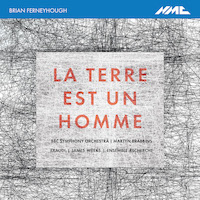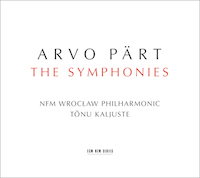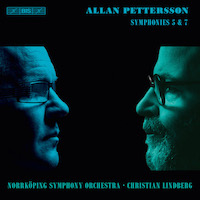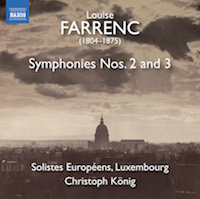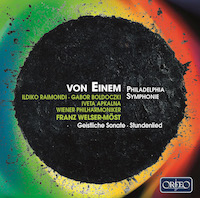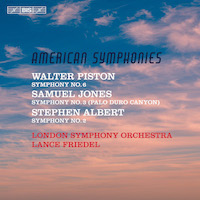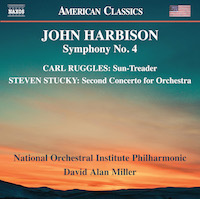Mostly Symphonies 33.
|
Grant Chu Covell [July 2018.]
Brian FERNEYHOUGH: Liber Scintillarum (2011-12)1; Plötzlichkeit (2005-06)2; Missa Brevis (1966-69)3; La Terre est un Homme (1976-79)4. ensemble recherche1, Olivia Robinson2, Jennifer Adams-Barbaro2 (sop), Cherith Milburn-Fryer2 (alt), EXAUDI3, James Weeks3 (cond.), BBC Symphony Orchestra2,4, Martyn Brabbins (cond.)2,4. NMC D231 (1 CD) (http://www.nmcrec.co.uk/). Ferneyhough may daze with his confident dispersal of mayhem and chaos. It is not easy to tell what is going on, and perhaps that’s part of his game. However, listen close and the orchestral handling is never more advanced than Schoenberg’s. There are countless moments in Plötzlichkeit and La Terre est un Homme where I would not have been surprised if a page turn had transported us to Berg’s Reigen. I dare say Ferneyhough is quaint because his argument is shrouded in traditional instrumentation. Maybe electronic bleeps a la Babbitt would be more appropriate, perhaps an eight-hands two-piano version would separate timbre from content. If we take Boulez as a measure of orchestral or pianistic prowess, Ferneyhough fails. Indeed the French school and Spectralism has left Ferneyhough’s echt-Verklärte palette far behind. This doesn’t mean that the chamber-sized Liber Scintillarum or the choral Missa Brevis are boring per se, just that their presentations don’t match their heady aims. Actually, the homogenous sound of the chorus satisfies, unlike the humdrum enormous forces required for La Terre est un Homme.
“Arvo Pärt: The Symphonies.” Arvo PÄRT: Symphony No. 1, “Polyphonic” (1964); Symphony No. 2 (1966); Symphony No. 3 (1971); Symphony No. 4, “Los Angeles” (2008). NFM Wrocław Philharmonic, Tōnu Kaljuste (cond.). ECM 2600 (1 CD) (http://www.ecmrecords.com/). Despite the profusion of recordings suggesting otherwise, Pärt was not always the composer of agreeable tonal listlessness. The first three symphonies were completed well before the transformative tintinnabuli phase, and they chronicle wrestling matches with the century’s big styles. One path through these four is to see them as evidence of a composer trying to make the biggest dent possible under an all-seeing Soviet state. Nos. 1 and 2 confront traditions, tossing around gestures for effect. Serialism is the subject of No. 1, whereas No. 2 kicks open the door to improvisation, randomness, and a sweet Tchaikovsky quote. Listeners must not be surprised by the avant-garde shenanigans and obnoxious chords spoiling idylls. As if aspiring towards a simpler time, No. 3 spreads an endless buffet of archaic cadences, but with majesty, as if Pärt were actually searching for a technique that could be magnanimous with the least amount of effort. I hear these symphonies – the first two especially – as simplistic forerunners to Schnittke. No. 4 is anchored in the manner to which Pärt is now firmly associated, however, it is dissonant, which can happen with certain combinations of white keys. Scored for strings, harp and percussion, it’s not clear how this relaxed gloom aligns with Los Angeles. Kaljuste has the advantage of following Salonen’s prior release, and all three movements are faster. Perhaps changes were made after the premiere. The coda does get up and go. Arvo Pärt: Four Symphonies
BIS 434 also contains Pärt’s nose-thumbing 1966 Cello Concerto and Perpetuum Mobile, Op. 10 (1963).
Allan PETTERSSON: Symphony No. 5 (1960-62); Symphony No. 7 (1966-67). Norrköping Symphony Orchestra, Christian Lindberg (cond.). BIS-2240 (1 SACD) (http://www.bis.se/). If this were a machine shop, you would be advised to don protective headgear. But no, these are the symphonies of Pettersson, and they grind and whine like no others, insisting upon splashing in the same grimy pool of suspicious water over and over again. Lindberg’s fluidity and the Norrköping Symphony Orchestra’s comfort is paying off. They do not grouse and stamp as much as they could considering the music’s gloominess and inertia (because of repetitions and phrases that return but never go anywhere). Five and Seven are single-movements, nearly 41 minutes each. Seven is lighter than Five. Seven is more familiar (the first recording was Doráti’s from 1969, now on an obscure Swedish Society SCD 1002) and Lindberg finds different balances and broadens the sunny section (rare in Pettersson) towards the end. Five is the one to take notice of. Imagine sour Bruckner, tossing on the open sea, unsure of how it will all end. Lindberg avoids an episodic approach, conceiving of the whole mass in one breath, reducing the contrast between the whining and the motives that push forward.
Louise FARRENC: Symphony No. 2 in D major, Op. 35 (1845); Symphony No. 3 in G minor, Op. 36 (1847). Solistes Européens, Luxembourg, Christoph König (cond). Naxos 8.573706 (1 CD) (http://www.naxos.com/). In this part of the world, they play a lot of Schubert symphonies on the radio. Farrenc would be a vast improvement. Like every successful symphony of its day, No. 2 owes substantially to Beethoven. No. 3’s minor key and snappy scherzo compares to Mendelssohn. Hearing either broadcast would cause a “driveway moment” to figure out what they are. Each Symphony’s four movements follow the standard design, and like Schumann and Mendelssohn, they strive towards bold contrasts. No. 3 is more memorable and represents an advance beyond No. 2’s classicism. It’s mystifying why there aren’t more recordings of these and why they aren’t frequently programmed – we do not need more Schubert symphonies on record. These two were not published during Farrenc’s lifetime, and apparently No. 3 was her last symphonic effort. Presumably the male-dominated climate at the Paris Conservatoire discouraged her from further innovations in the genre.
Gottfried VON EINEM: Philadelphia Symphony, Op. 28 (1961); Geistliche Sonate, Op. 38 (1962-73); Stundenlied, Op. 26 (1958). Ildikó Raimondi (sop), Gábor Boldoczki (tpt), Iveta Apkalna (org), Wiener Philharmoniker, Franz Welser-Möst (cond.). Orfeo C 929 181 A (1 CD) (http://www.orfeo-international.com/). Von Einem had already employed an appealing mixture of tonality and Romanticism before undertaking the Philadelphia Symphony. Ormandy had requested something along the lines of a concert opener but received this slightly more substantial opus. If von Einem’s style is anachronistic, this symphony, his third, is doubly so with its invented Colonialisms. It’s easy to picture its composer thumbing through history books and trying to fashion singable tunes like Yankee Doodle. The three movements are actually charming, balancing its re-enactments with modernist touches, including tango hints in the Finale. The 17-minute work was not premiered in Philadelphia: There was local resistance from the orchestra and other composers. The lush C-major symphony got its first airing by Solti in Vienna. Scored for soprano, trumpet and organ, the Sacred Sonata surprises with starkly exposed musical material. In four movements of shifting instrumentation, we hear texts from the Epistles of Paul and Psalm 103. Unlike the Symphony, the Sonata is spare and forbidding. The nine-part Stundenlied with text by Brecht plunges us back to an idealized 18th-century. Imagine Beethoven with wrong modulations and all-elbows rhythm. Von Einem succeeds in creating a particular agitated tonality with choral outbursts and orchestral emphasis.
“American Symphonies.” Walter PISTON: Symphony No. 6 (1955). Samuel JONES: Symphony No. 3, “Palo Duro Canyon” (1992). Stephen ALBERT: Symphony No. 2 (1992; completed by Sebastian CURRIER). London Symphony Orchestra, Lance Friedel (cond.). BIS-2118 (1 SACD) (http://www.bis.se/). Piston (1894-1976) was an important academic: His trilogy of instruction manuals (Harmony, Counterpoint and Orchestration) were essential to generations of music students well after his music had become forgotten. Written for the Boston Symphony Orchestra’s 75 anniversary, No. 6 applies Haydn’s proportions and scale. The Finale’s first theme might have engendered more abandon or bravado, however, Piston neatly absolves it, backing away from grandiosity. There may be hints of Shostakovich, Copland, Bartók and Martinů, but Piston indistinct style shies away from emulation. By the end of the 20th century, declaring allegiance to either populism or serialism was no longer necessary, thus Jones (b. 1935) and Albert (1941-92) could set off in any preferred direction. It is profoundly evident that Jones and Albert benefit from Sibelius’ influence: Jones’ sweeping Third emulates a Texan landscape, and musical ideas battle in Albert’s Second. These recent American symphonies embrace heroic cues which Piston shunned, such as consonant intervals and open fifths. Albert died in a car accident before completing his Second which may have been the first product in a new phase of development. Last mentioned here a decade ago, it is unfortunate we don’t hear more of his work. Friedel and the LSO tackle these symphonies with vivacity, advocating assuredly for each.
Carl RUGGLES: Sun-Treader (1926-31). Steven STUCKY: Second Concerto for Orchestra (2004). John HARBISON: Symphony No. 4 (2004). National Orchestral Institute Philharmonic, David Alan Miller (cond.). Naxos 8.559836 (1 CD) (http://www.naxos.com/). It is wonderful to hear Ruggles’ bone crunching Sun-Treader. Its fist-waving dissonance still stings, however, even at 15-minutes it does seem to wander. The single movement stands near the top of a mountain few others have dared to approach. The coda suggests a transition, but then the piece stops. Requested by Varèse, Ruggles took several years to complete his musings on a line by Robert Browning and missed the intended premiere deadline. As a genre, the Concerto for Orchestra may compete with the Symphony. Differences may be hard to define in situ, but symphonies seem to be about their composers whereas concertos for orchestra focus upon instruments. Stucky delivers a constantly changing vista across three parts. In the first movement, Stucky uses letter-for-note ciphers to acknowledge colleagues and others. With a concentration on bold brass and high winds, it is a vibrant, extroverted work. In contrast, Harbison’s introverted Fourth was created with smaller, finer brushes. This recording reveals particular contours and balances not previously audible. I hear a teensy allusion to Prokofiev’s Romeo and Juliet in the fourth movement Threnody. Harbison’s energy arrives in precise volleys. The NOI Philharmonic is an orchestra of young musicians and they attack each work with boldness and variety well beyond their years.
Albert, Farrenc, Ferneyhough, Harbison, Pärt, Pettersson, Piston, Ruggles, S Jones, Stucky, von Einem
[More Grant Chu Covell, Mostly Symphonies]
[More
Albert, Farrenc, Ferneyhough, Harbison, Pärt, Pettersson, Piston, Ruggles, S Jones, Stucky, von Einem]
[Previous Article:
Used Bin Troll Tweets HH.]
[Next Article:
Used Bin Troll Tweets II.]
|
